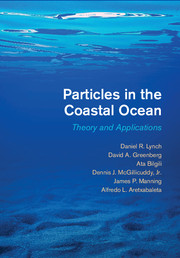Book contents
- Frontmatter
- Dedication
- Contents
- About the Authors
- Preface
- Acknowledgments
- List of Acronyms
- Definitions and Notation
- Introduction and Scope
- Part I Background
- Part II Elements
- Part III Applications
- 9 Noncohesive Sediment – Dense Particles
- 10 Oil – Chemically Active Particles
- 11 Individual-Based Models – Biotic Particles
- Part IV Appendices
- A Series, Sums, Limits
- B Complex Numbers
- C Wiener Integrals
- D Rates and Rate Limiters
- E Diffusion Solutions
- F Covariance Matrix for Shear and Convergence
- G Summary – ARn Recursions
- H Distribution Properties for Linear Triangles
- Bibliography
- Index
- Plate Section
9 - Noncohesive Sediment – Dense Particles
from Part III - Applications
Published online by Cambridge University Press: 05 January 2015
- Frontmatter
- Dedication
- Contents
- About the Authors
- Preface
- Acknowledgments
- List of Acronyms
- Definitions and Notation
- Introduction and Scope
- Part I Background
- Part II Elements
- Part III Applications
- 9 Noncohesive Sediment – Dense Particles
- 10 Oil – Chemically Active Particles
- 11 Individual-Based Models – Biotic Particles
- Part IV Appendices
- A Series, Sums, Limits
- B Complex Numbers
- C Wiener Integrals
- D Rates and Rate Limiters
- E Diffusion Solutions
- F Covariance Matrix for Shear and Convergence
- G Summary – ARn Recursions
- H Distribution Properties for Linear Triangles
- Bibliography
- Index
- Plate Section
Summary
Introduction
Sediments are dense particles. In still water they sink to the bottom. The introduction of bottom turbulence enables particle motion. At low turbulence, particles will bump or roll along the bottom. Higher turbulence will lift particles off the bottom. Once lifted, they are advected in the fluid flow, and dispersed by 3-D turbulent mixing. Near bottom, both turbulent diffusivity and horizontal advection increase with height; higher particles will move faster with larger random walks.
Bottom turbulence will have a sorting effect, with lighter particles moving higher and faster; and more often. The sorting will result in greater horizontal displacement for particles that fly high and long. When the shear is removed, the turbulence decays and particles sink.
We consider a single noncohesive particle and describe its motion. It is assumed that a 3-D circulation field is available, providing velocity, bottom stress, and eddy viscosity. Consistent with common practice, the computational bottom is slightly above the true bottom, with the fluid slipping horizontally above an idealized boundary layer, wherein the law of the wall governs. As particle motion is initiated by turbulence in this layer, it will be necessary to follow particle motions within and across it.
We will present the 3-D case first. Then, we will turn to the additional simplifications/assumptions necessary to deal with the vertically averaged case. The analysis introduced in Section 5.4 is developed more fully here for the bottom boundary.
Sediment dynamics is a mature field, and the coupling with hydraulic models is well established. The use of 3-D particle tracking is relatively new; comprehensive implementations include the PTM (MacDonald et al. [291]), PSED (Davies [102])and Sand Track (Soulsby et al. [428, 429]).
There will be several notational conventions. They will be introduced as needed; a summary is included in Section 9.15
Three States: P, M, B
In Figure 9.1 we illustrate the general arrangement of things. An individual particle will be in one of three states:
P: The pelagic or oceanic state. The Coastal Ocean Model is the gridded area at the top; it provides fluid velocity and bottom stress.
- Type
- Chapter
- Information
- Particles in the Coastal OceanTheory and Applications, pp. 297 - 336Publisher: Cambridge University PressPrint publication year: 2014



